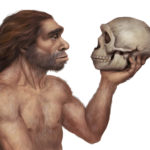For centuries, scientists have marveled at the dramatic differences between modern human faces and those of our closest evolutionary relatives. Compared to the robust, protruding features of Neanderthals and the pronounced muzzles of chimpanzees, human faces appear almost delicate. This remarkable transformation represents one of the most significant yet least understood aspects of human evolution. A groundbreaking new study published in Nature Communications now sheds light on this mystery, revealing how a combination of dietary changes, brain expansion, and social evolution reshaped the human face into its current form.

The Dramatic Transformation of the Human Face
When we examine fossil records, the contrast between modern human facial structure and that of Neanderthals or chimpanzees is striking. Modern human faces are not only smaller but also flatter, with less pronounced brow ridges, reduced jaw size, and a more vertical forehead. These differences become even more fascinating when we consider the relatively short evolutionary timeline—modern humans and Neanderthals shared a common ancestor just 500,000 to 700,000 years ago, while our lineage diverged from chimpanzees a mere 6 to 8 million years ago.
Brain Expansion and Its Impact on Facial Structure
Another critical factor was the dramatic expansion of the human brain. As cranial capacity increased from approximately 450 cubic centimeters in early hominins to 1,350 cubic centimeters in modern humans, the skull underwent a profound reorganization. The face, which had once projected forward to accommodate powerful chewing muscles, gradually receded beneath an expanding braincase.
This shift was not merely a matter of proportion but also of biomechanics. The development of a more rounded skull and a flatter face allowed for better balance of the head atop the vertebral column, an adaptation that coincided with the evolution of fully upright posture and bipedal locomotion. The reduction of heavy brow ridges and the development of a more vertical forehead were further consequences of this cranial restructuring.
Comparative Anatomy: Humans vs. Neanderthals vs. Chimps
| Feature | Modern Humans | Neanderthals | Chimpanzees |
|---|---|---|---|
| Facial Projection | Minimal | Pronounced | Extreme |
| Brow Ridges | Small | Large | Moderate |
| Jaw Strength | Reduced | Powerful | Very Strong |
| Brain Case | Rounded | Elongated | Small |
Implications for Understanding Human Evolution:

The Genetic Underpinnings of Facial Evolution
Recent advances in genetics have revealed that numerous genes influence facial development. Variations in genes such as BMP4, RUNX2, and DLX family members are associated with differences in jaw size, brow ridge prominence, and overall facial shape. Some of these genetic changes appear to have been under strong selective pressure during recent human evolution, suggesting that facial reduction conferred significant survival advantages.
Conclusion: The Human Face as a Window into Our Past
TWhy Humans Have Smaller Faces Than Neanderthals
Modern humans evolved smaller faces than Neanderthals due to dietary changes (softer cooked food), brain expansion, and social needs. Our flatter facial structure developed as chewing demands decreased and brain size increased. Unlike Neanderthals’ robust features for cold adaptation, humans developed more expressive faces for communication. This evolutionary shift reflects our species’ unique cognitive and social development.
Also Check this Out !! Neanderthal Genes: East Asia’s Lactose Tolerance Secret











